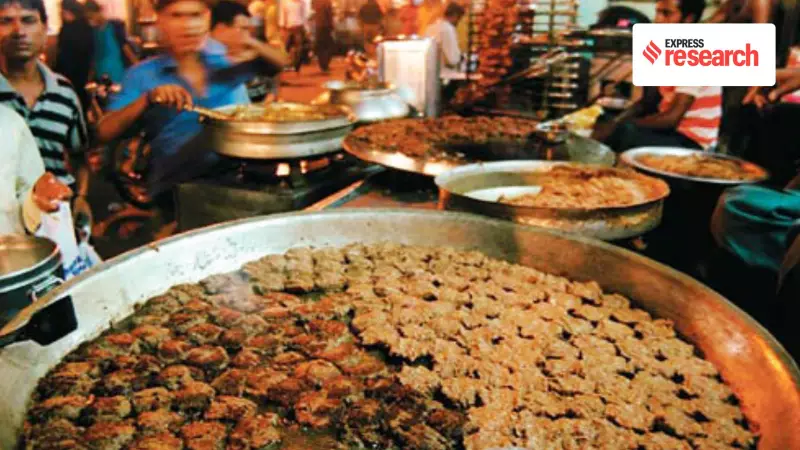
The recent UNESCO City of Gastronomy designation for Lucknow celebrates more than just Nawabi culture—it honors a culinary tradition that has been cherished by aristocrats, middle-class families, and common people alike for centuries. This recognition places Lucknow among approximately 55 cities worldwide, including its Nawabi counterpart Hyderabad, in a global network of gastronomic excellence.
The Art of Dastarkhwan: Royal Dining Etiquette
At the heart of Awadhi culinary tradition lies the dastarkhwan, an elaborate code of dining etiquette developed by the nawabs of Awadh. Historian Prof. Nina Sabnani notes in her 2015 work that this ceremonially laid-out dining spread was treated with such reverence that stepping on the cloth itself was strictly forbidden.
The traditional dastarkhwan featured at least twelve different dishes, with the meal beginning with guests washing their hands in a chilamchi (hand-washing pot). The culinary journey would commence with a seasonal sharbat (juice), followed by shorba (soup), before progressing to the main course featuring legendary kebabs like galawati and kakori, accompanied by various breads and rice preparations.
Today, the legacy continues as numerous establishments in Lucknow's oldest neighborhoods proudly display 'Dastarkhwan' on their signboards, preserving this centuries-old tradition.
Royal Kitchens and Culinary Evolution
The history of Lucknow's classical cuisine traces back to Nawab Shuja-ud-Daula's reign (1754-75), who appointed culinary expert Mirza Hasnu as head of the royal kitchen. According to historical accounts, an astonishing two thousand rupees was spent daily on food alone during this period, excluding staff wages.
The royal kitchens operated under a strict hierarchy:
- Scullions cleaned enormous pots and worked under cook supervision
- Bavarchi prepared meals in large quantities
- Rakabdar, the head chef, cooked for select individuals and adorned dishes with edible silver foil and fruit carvings
When Nawab Asaf-ud-Daula moved the capital from Faizabad to Lucknow in 1775, the city transformed into a flourishing cultural center. Cooks in the bawarchikhanas (royal kitchens) worked under a guiding principle: food must appeal to all senses—visually beautiful, aromatically pleasing, and exquisite in taste.
Signature Dishes and Cooking Techniques
Unlike Mughal cuisine rich in spices and cream, Awadhi cuisine developed subtler flavors. The nawabs preferred cream over curd, lamb instead of mutton, and delicate spice blends that wouldn't overpower the fragrance of local rice used in pulao.
Yakhni Pulao emerged as the royal favorite over biryani, which the nawabs considered barbaric in style. Historian Rana Safvi explains that making pulao is far more challenging than biryani because it relies on very few spices, making cooking technique paramount.
The legendary dum pukht cooking technique originated during a famine in 1847, when Nawab Asaf-ud-Daula employed thousands in constructing Bada Imambara through a food-for-work program. Large cauldrons filled with rice, meat, and vegetables were sealed to create one-pot meals for workers, giving birth to the slow-cooking method where dum means 'breathe in' and pukht means 'cook'.
Lucknow's kebab tradition remains unparalleled, with the city famous for galauti, kakori, boti, and seekh kebabs. Another culinary legend gave birth to shahi tukda—a dessert created from stale bread pieces collected from the nawab's donations to the poor, deep-fried and transformed with sugar syrup and reduced milk.
Post-1857 Transformation and Modern Legacy
The Nawabs' reign ended in 1856 when the East India Company took control of Awadh, exiling the last Nawab, Wajid Ali Shah, to Calcutta. Significantly, he took his cooks with him, spreading Lucknow's culinary influence to Bengali cuisine.
Cultural historian Pushpesh Pant emphasizes that Lucknow's food heritage extends beyond Nawabi traditions. After Independence, immigrants from West Punjab introduced tandoor dishes, while communities from eastern Uttar Pradesh and Bihar brought chokha bati to street food culture.
Today, old markets like Chowk, Ameenabaad, and Hazratganj house legendary establishments including Raheem's Kulcha Nahari, Idrees Biryani, and Tunday Kababi. The city's gourmet culture continues to thrive, with emphasis on presentation where, as Safvi notes, 'the eyes eat before the mouth.'
The UNESCO recognition rightly celebrates not just Nawabi aristocracy but the contributions of all communities that have shaped Lucknow's diverse culinary landscape, making it a city that truly wakes up to the aroma of food rather than alarms.





